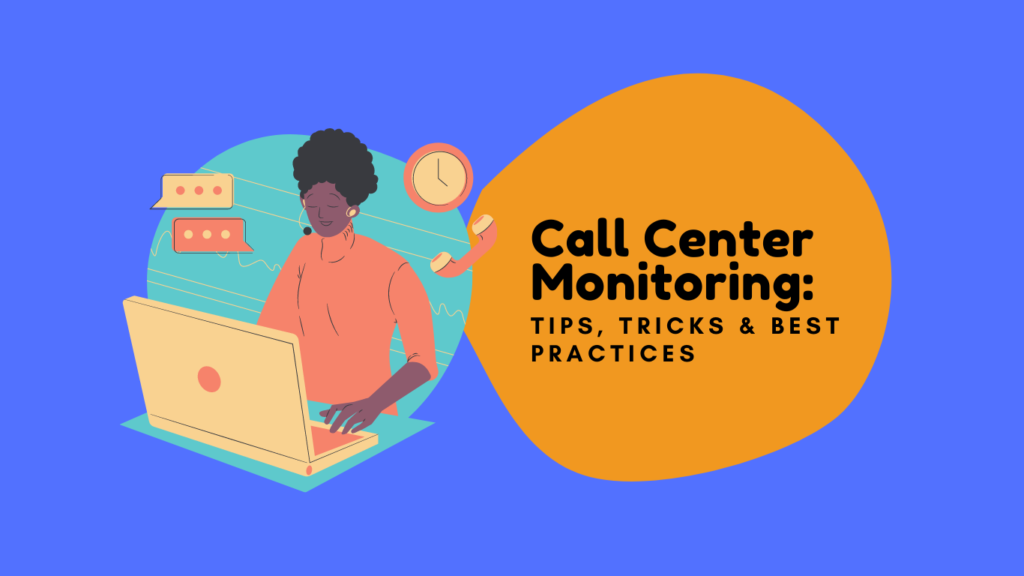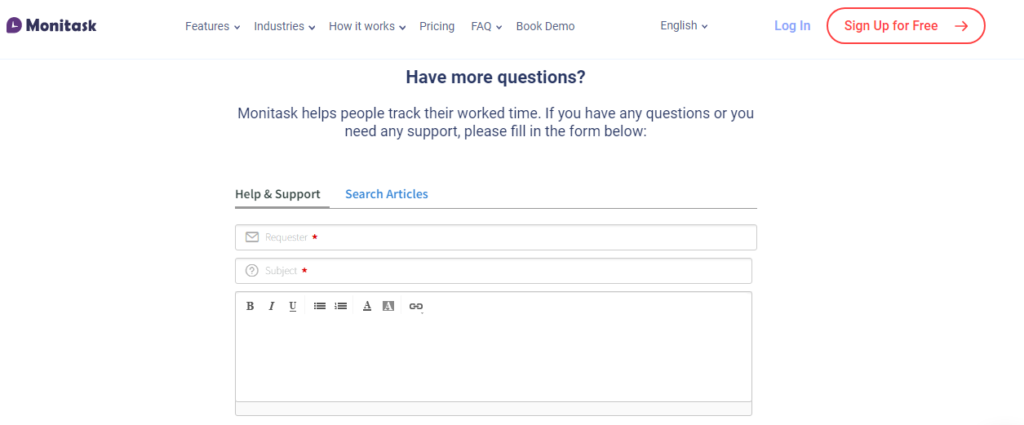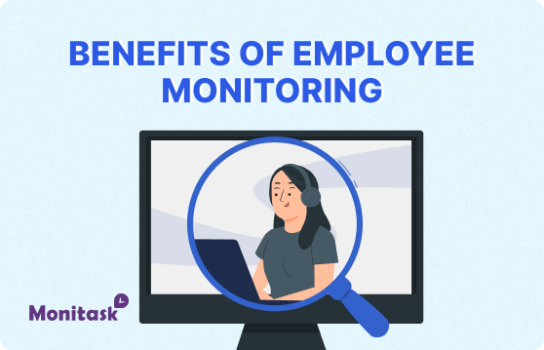Everything You Need to Know About Call Center Monitoring: Tips, Tricks & Best Practices

WAIT! Call centers are still a thing? Surprisingly enough, they are! Even though we have all this mouth-dropping technology, people still prefer human contact, and call centers do the work. If you stumbled upon this blog post it means you are either running a call center or you are planning on settling one, either way, it’s important to continuously perform call center monitoring!
In this blog post, we’ll discuss tips, tricks, and best practices for call center monitoring. We’ll also answer some common questions about calls monitoring. So, if you’re looking to improve your call center’s performance, this blog post is for you!

Call Center Evolution And The 1-800 Number
The call center industry has a long and interesting history. The concept originated in the early 1970s, by that time, telephone calls were mostly made for business purposes. However, with the advent of toll-free numbers, aka the 1-800 number, businesses began to use them as a way to connect with their customers.
Toll-free numbers allowed businesses to offer callers a free way to reach them. A game-changer move as it encouraged customers to call!
The industry continued to grow throughout the late 1970s and 1980s. Businesses began to outsource their call center operations to save money. In the early 1990s, call centers began to pop up in countries with cheaper labor costs, such as India and the Philippines.
By 2006, there were more than 30,000 call centers in operation around the world. The industry has continued to grow since then. So much, that it’s now a $339,4 billion industry with 15 million call center agents employed worldwide. Today, call centers are an important part of many businesses. They are used by companies in a variety of industries, including healthcare, banking, and retail.
What hasn’t changed over time is the importance of monitoring call center performance. Whether you’re running a small operation or a large one, it’s essential to track call center metrics and use that data to improve your business.
So, let’s dive into the topic!
What Is A Call Center?
When we read the words “call center” the first image that pops up in our minds is a bunch of people sitting on desks with phones at hand, and while this is not that far from reality, we can’t square down the purpose of a call center to only this.

Call centers are often associated with customer support. But, as well they can be used for telemarketing, market research, and debt collection
Call centers are a type of contact center that handles interactions with existing and potential customers through phone calls and other types of communication channels. Call centers are typically operated by businesses that receive a high volume of phone calls, such as airlines, banks, and food delivery services.
These centers are typically staffed by customer service representatives (CSRs) who are trained to handle a wide range of customer inquiries. As well, call center operations are typically monitored by quality assurance (QA) specialists to ensure that calls are being handled in an efficient and effective manner. These centers aren’t far away from tech and typically use a variety of software applications to manage call flow and track customer interactions.
Types Of Call Centers
If you are still unsure about how to carry on at a call center, don’t fret! Call centers can be quite flexible in their structure, meaning that you can adapt them to your specific needs and goals.
Depending on your budget, your company’s mission and vision, and objectives, you can choose the type of call center that fits best. Will you choose in-house, outsourced, or a blended call center?
In-house Call Centers
In-house call centers are a type of customer service center that is owned and operated by the same company that provides the product or service being advertised.
These call centers handle all customer interactions for the organization, including phone calls, emails, and live chat sessions.
PROS: When you choose to have an in-house call center, you win complete control over your customer service operation. You can handpick your call center agents, train them according to your company’s standards, and monitor their performance on a regular basis.
In-house call centers agents have the potential to build stronger relationships with customers since they are more likely to be familiar with the company’s products.
As well, you have access to real-time data. This data can be used to improve your call center’s performance and make necessary changes in real-time.
Outsourced Call Centers
Outsourced call centers are a popular solution for businesses that need to provide customer support but don’t have the internal resources to do so. By outsourcing call center services, businesses can save money and focus on their core competencies.
Call centers also offer a number of other benefits, such as increased flexibility and scalability. These call centers typically specialize in a specific industry or type of customer interaction, such as telemarketing or technical support.
PROS: Outsourcing call center services is a popular option for small businesses and startups. It’s a cost-effective way to provide excellent customer service without having to invest in the infrastructure and personnel required to run a call center.
Blended Call Center
Blended call centers have become increasingly popular in recent years. A blended call center is a customer service center that uses a combination of in-house and outsourced call center agents.
This type of call center is often used by businesses that have a high volume of customer interactions. The goal of a blended call center is to provide an improved customer experience by handling both customer service and sales calls in one place. This allows customers to get the help they need without being transferred to another department.
PROS: When you choose a blended call center, you only pay for the call center services you selected in the first place. As a result, you can provide a higher level of service while also reducing costs. Also, you can keep a portion of the control of the customer service experience.
Remember that no matter what type of call center you choose, the goal is always the same: to provide excellent customer service!
Remember we said a call center can’t be reduced to only picking up a phone call? It’s time to learn about all the services call centers provide.
Call Center Services
These are one of the most common call center services:
Inbound Call Center Services
Inbound call centers are the most commonly used call center service. They are responsible for handling customer service inquiries, complaints, and product questions. The call center representatives handle inbound calls from customers who want to order a product, make a reservation, or cancel an appointment.
They are typically open during business hours, and they use a variety of tools to keep track of calls and ensure that they are handled in a timely manner. Inbound call center services can be an invaluable resource for businesses, providing a way to improve customer satisfaction and increase sales.
Outbound Call Center Services
Outbound call centers make outgoing calls to current and potential customers on behalf of the company. These calls can be sales calls, debt collection calls, or political polls. The goal of an outbound call center service is to reach as many people as possible in a short period of time.
As well, as to contact customers who have shown interest in the products or services that the company offers. This type of service it’s a great way for businesses to promote their brand and increase sales.

Social Media Support
Social media support call centers provide a valuable service to businesses by handling customer inquiries and complaints through platforms such as Facebook, Twitter, and Instagram.
These call centers are staffed with skilled customer service representatives who are trained in Social Media Support Protocols (SMSPs). In addition to providing prompt and polite service, social media support call centers help to resolve issues quickly and efficiently. This not only benefits the customers but also helps to protect the reputation of the business.
Email Support
Email support is a call center service to help customers resolve issues or answer questions via email. Email support is typically used for less urgent issues that can be resolved through written communication. Many call centers use call center monitoring software to track and manage email support requests.

Live Chat Support
This service allows customer service agents to help clients in real-time through live chat software. This type of call center service is beneficial as it allows businesses to provide immediate assistance to any customer issues.
A call center can’t be only one thing. It’s a complex system made of different call center services that work together to provide excellent customer service.
Now, it’s time to get into depth about how to start monitoring your call center’s performance!
A Brief History of Call Center Monitoring
The call center monitoring process began in the early days of call centers when managers would listen in on calls to see how their employees were performing. This was (and still is) known as call listening or call monitoring.
With the advent of digital recording technologies, call center managers can now record calls and listen to them at their convenience. This made it easier to identify training opportunities for employees and improve customer service overall.
Nowadays, call center monitoring has evolved into a much more complex process. In addition, to call listening and recording, data analysis has become a crucial part of call center monitoring.
Managers now use data analytics tools to gain insights into their call center’s performance. They can then use these insights to make informed decisions about how to improve their call center’s performance.
But, What Exactly Is Call Center Monitoring?
Call center monitoring is the process of tracking call center performance metrics in order to identify trends and areas for improvement. Call center monitoring can be done manually, by listening to call recordings and reviewing call logs, or it can be done automatically, using call center software that tracks metrics such as call length, call volume, call abandonment, and average handle time.
Call center managers use call center monitoring to improve agent performance, optimize call center operations, and ensure that customers are satisfied with the level of service they receive. In addition, call center monitoring can also be used for compliance purposes, such as ensuring that agents are following company policies and procedures.
Why Is Call Center Monitoring Important?
Call center monitoring is essential for a variety of reasons. First, it helps to ensure that calls are handled in a professional and efficient manner. Call center agents are the face of the company, and it is important that they represent the company in a positive light.
Second, call center monitoring can help to identify areas where improvement is needed. By listening to calls and evaluating agent performance, managers can identify areas where training is needed or processes need to be changed.
Finally, call center monitoring can help to protect the privacy of customers and employees. Call recording and monitoring help to ensure that customer information is protected and that employees are not sharing confidential information.
Call center monitoring is a never-ending cycle of making sure your call center is running smoothly and efficiently
In short, monitoring your call center:
- Allows you to identify call center issues early on and fix them before they become bigger problems.
- Helps you track call center KPIs (Key Performance Indicators) and identify trends.
- Provides valuable feedback that can be used to improve the call center’s overall performance.
Now, every strategy needs a toolkit, right? Let’s review what you need to monitor your call center!
Call Center Technology
Call center technology has come a long way in recent years, and there are now many different software programs and tools available to help call center managers monitor and improve performance.
These tools include:
- Call Recording Software: This type of software records calls made to and from your call center. Call recordings can be used to measure things like call quality and average handle time.
- CRM (Customer Relationship Management) System: This type of software helps call center managers store customer information and track customer interactions.
- Customer Satisfaction Surveys: Surveys are a great way to collect subjective data about your call center’s performance. Customer satisfaction surveys can be sent out after each call or on a regular basis.
- Workforce Management Software: This software helps call centers optimize their workforce by managing employee schedules, tracking attendance, and analyzing productivity.
- Analytics Software: Analytics software can be used to track key call center metrics, like average handle time and first call resolution rate.
- Quality Management Software: This software helps call centers manage quality assurance programs by providing features such as call recording, call scoring, and agent performance reports.
There are many different types of call center technology available, and the best way to choose the right technology for your call center depends on your specific needs and goals.
Types of Data Used in Call Center Monitoring
The tools we mentioned above gather data, but which type of information? There are two main types of data used in call center monitoring:
- Objective data is quantifiable and can be measured using tools like call recording software.
- Subjective data is more qualitative and often collected through surveys or customer interviews.
Objective data can be used to track call center KPIs, while subjective data can provide valuable insight into the customer experience. Both types of data are important for call center monitoring. By collecting both objective and subjective data, you can get a well-rounded view of your call center’s performance.
Now that we’ve reviewed the basics of call center monitoring, let’s take a look at some specific tips and best practices!
Effective Call Center Quality Monitoring Best Practices
Monitoring call centers can be a complex and daunting task. Contact center staff are bound to dive deep into any call to find detailed knowledge to analyze, understand, and share data.
It’s not a secret that customer experiences are critical to your business’ success. How does one start? How should you monitor the call quality in contact centers? By following these best practices you can get started on the right track:
First, Define Your Goals
The first step in any call center monitoring plan is to define your goals. What do you want to achieve with call center monitoring? Do you want to improve customer satisfaction? Increase first call resolution rates? Reduce average handle time? Once you have a clear idea of your goals, you can start to develop a plan for how to achieve them.
Build The Right Quality Assurance Team
Call center quality assurance (QA) is vital for ensuring that customers have a positive experience and that calls are handled efficiently. Therefore, to ensure call center quality, you need a great QA team!
Call center QA teams help to identify areas where agent performance can be improved and work to develop solutions that will improve the overall quality of the call center. Typically, this team includes contact center managers, supervisors, and your best-informed customer service reps.
By developing a QA team, call centers can improve their overall quality monitoring and ensure that their customers receive the best possible service.
Set Your Call Quality Standards & Key Performance Indicators (KPIs)
The first step is to set call quality standards and KPIs. This will give managers something to aim for when it comes to analyzing call recordings and observing live calls. But what should these call quality standards entail?
They should be based on three main criteria:
- The ability of the agent to handle customer interactions
- The overall satisfaction of the customer
- How efficiently the interaction was handled
In order to stay ahead of the competition, it’s important to regularly review and update your call center KPIs. Here are some of the most important call center metrics for 2022:
- First Call Resolution Rate: This metric measures the percentage of calls that are successfully resolved on the first attempt.
- Average Handle Time: This metric measures the average amount of time that it takes to handle a call from start to finish.
- Abandonment Rate: This metric measures the percentage of calls that are abandoned by customers before they are answered by an agent.
- Customer Satisfaction Score: This metric measures the customer’s satisfaction with the call center experience on a scale of 0-100.
- Average Speed of Answer Time Rate: This metric measures the average amount of time that it takes for an agent to answer a call.
Pick a Dashboard
A dashboard is a great way to see all of your call center’s key performance indicators (KPIs) in one place. By tracking KPIs on a dashboard, you can quickly identify trends and areas for improvement.

There are many different types of call center dashboards available, so be sure to choose one that meets your specific needs.
Create a Call Monitoring Scorecard & Audit Process
After you’ve established your call quality standards, you need to create a scorecard and audit process. This will help ensure that every call is given the same level of attention when it comes to monitoring. See the image below for a great example!

TIP: To ensure that each call is being evaluated fairly, it’s important to calibrate call recordings. This means listening to a call recording with a group of people and having everyone rate the call using the scorecard. This will help create consistency in how calls are evaluated and scored.
Implement Tools to Help Monitor, Analyze and Improve
On the market, you have numerous quality control solutions that can be used to improve contact center quality. List some good quality monitoring software tools to make your call quality management tool easier. These tools aim to improve customer experience, improve productivity and improve profitability.
Involve Agents in the Call Quality Monitoring Process
Agents must be active in these processes as they are the frontline people who deal daily with clients. In order to get the most accurate picture of call quality, it is important to involve agents in the process. Call center agents can provide valuable insights into the calls, including what went well and what could be improved.
In addition, involving agents in the call quality monitoring process can help to improve morale and communication within the call center.
TIP: When agents feel like they are a part of the process, they are more likely to be motivated to provide excellent customer service.
Keep Everyone in the Quality Loop
Quality monitoring process assurance programs work best when all stakeholders are informed – especially executives and managers at the top level. Call center managers typically communicate the results of call quality monitoring to the customer service teams on a regular basis, in order to ensure that everyone is aware of the importance of providing high-quality customer service.
By communicating the results of call quality monitoring, call center managers can help to motivate their staff and ensure that everyone is working together to provide the best possible service to customers.
TIP: You can put available all the automated call recordings, monitoring, and analysis by using interactive quality dashboards.
Essential Tips for Monitoring Call Center Performance: Wrapping Up
In a nutshell, here are some tips for call quality monitoring performance:
- Set Clear Goals and KPIs: Without clear goals, it will be difficult to measure your call center’s success. Make sure you set KPIs that are relevant to your business objectives.
- Collect Data Regularly: To get an accurate picture of your call center’s performance, you need to collect data on a regular basis. This data can be collected manually or through call recording software.
- Analyze Data Regularly: Once you’ve collected data, it’s important to analyze it on a regular basis. This will help you identify trends and areas for improvement. Look for patterns and trends in the data. Are there certain times of day when call volume is higher? Are calls being abandoned more often during peak hours?
- Implement Change: Once you’ve analyzed your data and identified areas for improvement, it’s time to implement change. This could mean making changes to your call center’s staffing levels, training your employees on new techniques, or changing the way calls are routed. Whatever changes you make, be sure to track their impact on call center performance.
- Rinse and Repeat Steps: Start the cycle again as often as needed to ensure that your call center is performing at its best. Monitoring call centers can be a complex and daunting task, but following these tips will help you get started on the right track.
Final Considerations
Monitoring call center performance is essential for any business that wants to improve its customer service.
By monitoring your call center performance, you can identify areas where agents need improvement and make the necessary changes. Additionally, by tracking customer satisfaction levels, you can ensure that your customers are happy with the service they’re receiving.
If you’re not currently using a call center monitoring solution, consider giving one a try – it could be the difference between retaining customers and losing them to the competition.


